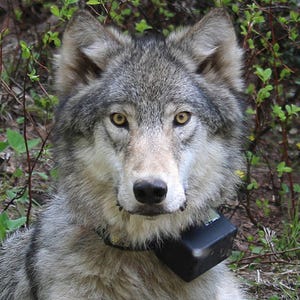Oregon's growing wolf population showed no signs of slowing down in 2015.
The number of Canis lupus increased by 36 percent in Oregon last year to an estimated 110 animals, according to the Oregon Department of Fish and Wildlife’s annual wolf report.
Despite a politically raucous year that saw wolves removed from the state endangered species list — and a lawsuit filed by environmentalists to challenge that decision — the report shows wolves expanding in numbers and territory.
ODFW documented 11 breeding pairs of wolves in 2015, up from nine in 2014. The agency also counted 33 pups born in 2015 that survived through though Dec. 31.
The numbers are more of an estimate than an hard number, ODFW officials stressed, noting that the real number is likely higher than 110.
“As predicted, Oregon’s wolf population has continued to expand its range and grow in number,” said Russ Morgan, ODFW wolf coordinator. “While northeast Oregon continues to have the highest number of wolves, there is also continued movement of wolves into southern Oregon.”
Morgan said the population growth was driven by three main factors: healthy reproduction, survival through the winter and expansion into new territory.
There are now 10 wolves and four areas of known wolf activity in Western Oregon — classified as west of Highway 395 — clustered to the north and west of Klamath Falls. The trailblazing wolf OR7 and his Rogue Pack account for six of those wolves south of Crater Lake National Park.
Morgan said it's likely that wolves are settling in other parts of the Cascade Range as well.The number of Canis lupus increased by 36 percent in Oregon last year to an estimated 110 animals, according to the Oregon Department of Fish and Wildlife’s annual wolf report.
Despite a politically raucous year that saw wolves removed from the state endangered species list — and a lawsuit filed by environmentalists to challenge that decision — the report shows wolves expanding in numbers and territory.
ODFW documented 11 breeding pairs of wolves in 2015, up from nine in 2014. The agency also counted 33 pups born in 2015 that survived through though Dec. 31.
The numbers are more of an estimate than an hard number, ODFW officials stressed, noting that the real number is likely higher than 110.
“As predicted, Oregon’s wolf population has continued to expand its range and grow in number,” said Russ Morgan, ODFW wolf coordinator. “While northeast Oregon continues to have the highest number of wolves, there is also continued movement of wolves into southern Oregon.”
Morgan said the population growth was driven by three main factors: healthy reproduction, survival through the winter and expansion into new territory.
There are now 10 wolves and four areas of known wolf activity in Western Oregon — classified as west of Highway 395 — clustered to the north and west of Klamath Falls. The trailblazing wolf OR7 and his Rogue Pack account for six of those wolves south of Crater Lake National Park.
"We're able to track the wolves in Southern Oregon because many of them have radio collars, but the greater number of wolves in Oregon don't have the collars," Morgan said. "There could very well be wolf activity in other parts of the Cascades that we just don't know about."
Beyond the spread of wolves in Oregon, perhaps the biggest takeaway from this year's report was the decline in attacks on livestock, Morgan said.
ODFW investigations confirmed nine incidents of wolves killing livestock and two probable incidents. The result was 14 animals killed by wolves in 2015.
In contrast, there were 11 confirmed depredations and 32 livestock killed in 2014. Twelve animals were lost to wolves in 2013 and 2012.
"It's really difficult to tell why depredations are down one year and up the next, and that trend could reverse at any time," Morgan said. "I would say that many livestock producers have taken really good, non-lethal steps to minimize depredation and some of those efforts many be paying off."
ODFW distributed $174,428 to address wolf-livestock conflict, including $119,390 used for preventative measures and $14,018 paid to ranchers for confirmed losses.
Not all the news was good for wolves.
ODFW documented seven wolf mortalities in 2015. Three were illegally shot, one ingested a chemical that is poisonous to animals and a five-month-old pup found dead in the Catherine Pack rendezvous area appeared to die of natural causes. The cause of death of the Sled Springs breeding male and female found dead in August is unknown.
Oregon State Police are still actively investigating many of these cases. A Baker City man pled guilty to shooting one of the collared wolves and was fined $2,000 and ordered to forfeit his rifle to the state.
Wolves started to arrive in northeast Oregon during the late 1990s, migrating from the population reintroduced to central Idaho by the U.S. Fish and Wildlife Service beginning in 1995.
The first pups were born in the Beaver State in 2008, and the numbers slowly grew, hitting 14 in 2009 and 29 by 2011.
While Monday's report shows that wolves are spreading, they still only take up a sliver of their potential habitat in Oregon, according to Oregon State University professor Bill Ripple. In a 2006 study, Ripple estimated that Oregon could support an estimated 1,400 wolves statewide, with the Cascade region home to about 600 wolves.
Morgan said the report confirmed what ODFW had projected — that the wolf population is growing at a healthy rate.
"This was pretty much what we expected," Morgan said. "It just shows that wolves have a tremendous ability to pioneer new areas and be successful. We expect that will continue."
source




No comments:
Post a Comment